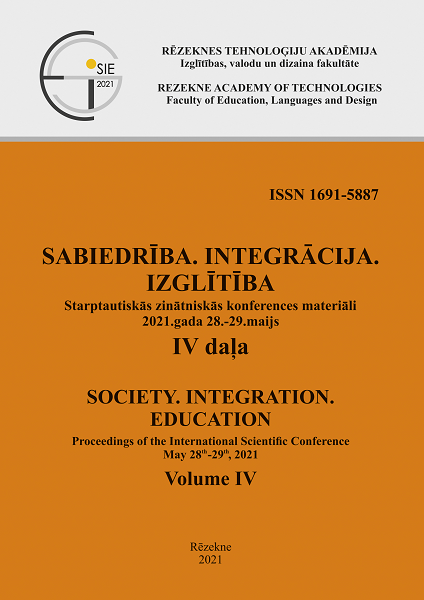BRIDGING THE CITY: CONNECTING ART, PERFORMANCE DESIGN, ENVIRONMENT AND EDUCATION
DOI:
https://doi.org/10.17770/sie2021vol4.6412Keywords:
arts-based research, knotworks, networks, participatory infrastructure, participatory performance design, performance pedagogyAbstract
This study explores knotworks and networks within art, participatory performance design, the environment and education specialists and institutions within the case-project “Nomadic Radical Academy”, realised in 2019 and 2020. The novelty of the research lies in its investigation of how international collaborations impact the performance pedagogy project at the local level. The project bridged a wide spectrum of actors in order to design an interactive space and participatory infrastructure involving a diverse variety of stakeholders. The projects were created by the author of this paper and involved the art venue Gallery Meno Parkas in Kaunas, local Kaunas schools and environment-friendly local art initiatives, families in Kaunas, Kaunas Municipality, The Lithuanian Council for Culture, a performance designer and international artists from the Baltic-Nordic region. The author created the performative milieu in the gallery space with the intention of educating children and young people about the environment and climate change through performance pedagogy methods. The research question is as follows: How are the knotworks and networks created during the planning and realisation of the international performance pedagogy project, and how do they target the local community and influence projects locally in real-time? The study materials were collected by arts-based methods and analysed by utilising reflexive research. The data collected during the planning and implementation phases are the author’s notes and reflections, notes from feedback and discussions with the involved artists and photos and videos. This research can be valuable to educators, performance designers and artists interested in knotwork- and network-building. This research focused on the planning and realisation of the project by involving international performance professionals in site-specific projects designed for local communities.
References
Barone, T., Eisner, E. (2012). Arts based research. Los Angeles: Sage.
BiteVilnius. (2020). Retrieved from www.bitevilnius.nu
Bødker, S., Dindler, C., & Iversen, O. S. (2017). Tying knots: Participatory infrastructuring at work. Computer Supported Cooperative Work (CSCW), 26(1-2), 245–273. doi: 10.1007/s10606-017-9268-y
Gärtner, J., Wagner I. (1996). Mapping Actors and Agendas: Political Frameworks of Systems Design and Participation. Human-Computer Interaction, 11, 187–214. doi: 10.1207/s15327051hci1103_1
Griniuk M. (2020) Performance Pedagogy: Performing Fluxus Pedagogy in a Contemporary Lithuanian Context, Acta Paedagogica Vilnensia, 440, 152–163. doi: 10.15388/ActPaed.44.11.
Goffman, E. (1959). The presentation of self in everyday life. Garden City, NY: Doubleday.
Hammersley, J., & Knowles, R. V. (2016, July). The Dialogic: art work as method. In National Association of Fine Art Educators (NAFAE) Fine Art Research Network Symposium. National Association of Fine Art Educators.
Karasti, H. (2014, October). Infrastructuring in participatory design. In Proceedings of the 13th Participatory Design Conference: Research Papers-Volume 1, 141–150.
Kensing, F. & Blomberg J., (1998). Participatory design: Issues and concerns. Computer Supported Cooperative Work, 7, 167–185. doi: 10.1023/A:1008689307411
Leavy, P. (2015). Method meets art. arts-based research practice (2nd ed.). New York: The Guilford Press.
Pineau, E. L. (1994). Teaching is performance: Reconceptualising a problematic metaphor. American Educational Research Journal, 31(1), 3–25. doi: 10.3102/00028312031001003.
Rothman, J. (2014). Reflexive pedagogy: Teaching and learning in peace and conflict studies. Conflict Resolution Quarterly, 32(2), 109–128. doi: 10.1002/crq.21107
Schechner, R. (1977) Essays on Performance Theory: 1970–1976. New York: Drama Book Specialists.
Star, S. L. & Bowker G. C., (2002). How to infrastructure. In L.A. Lievrouw and S. Livingstone (Eds): The Handbook of New Media, 151–162. London: SAGE,
Star, S. L. & Ruhleder K., (1996). Steps toward an Ecology of Infrastructure:
Borderlands of Design and Access for Large Information Spaces. (n.d.). Information Systems Research, 7(11), 111–134. doi: 10.1287/isre.7.1.111
Weber, R. (2003). Editor’s comments: The reflexive researcher. MIS Quarterly, 27(4), v. doi: 10.2307/30036546






